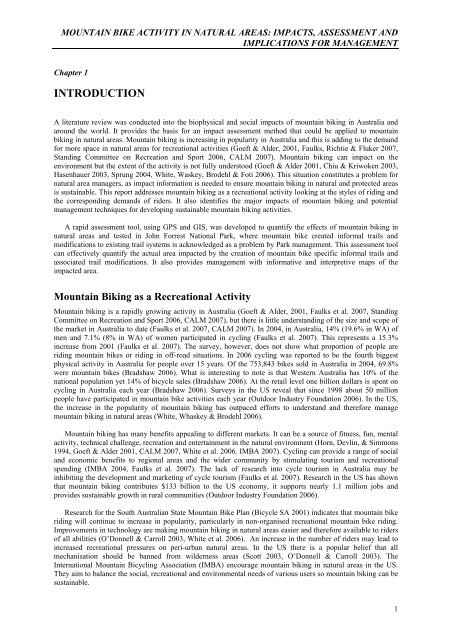Mountain bike activity in natural areas - Murdoch Research ...
Mountain bike activity in natural areas - Murdoch Research ...
Mountain bike activity in natural areas - Murdoch Research ...
Create successful ePaper yourself
Turn your PDF publications into a flip-book with our unique Google optimized e-Paper software.
MOUNTAIN BIKE ACTIVITY IN NATURAL AREAS: IMPACTS, ASSESSMENT AND<br />
IMPLICATIONS FOR MANAGEMENT<br />
Chapter 1<br />
INTRODUCTION<br />
A literature review was conducted <strong>in</strong>to the biophysical and social impacts of mounta<strong>in</strong> bik<strong>in</strong>g <strong>in</strong> Australia and<br />
around the world. It provides the basis for an impact assessment method that could be applied to mounta<strong>in</strong><br />
bik<strong>in</strong>g <strong>in</strong> <strong>natural</strong> <strong>areas</strong>. <strong>Mounta<strong>in</strong></strong> bik<strong>in</strong>g is <strong>in</strong>creas<strong>in</strong>g <strong>in</strong> popularity <strong>in</strong> Australia and this is add<strong>in</strong>g to the demand<br />
for more space <strong>in</strong> <strong>natural</strong> <strong>areas</strong> for recreational activities (Goeft & Alder, 2001, Faulks, Richtie & Fluker 2007,<br />
Stand<strong>in</strong>g Committee on Recreation and Sport 2006, CALM 2007). <strong>Mounta<strong>in</strong></strong> bik<strong>in</strong>g can impact on the<br />
environment but the extent of the <strong>activity</strong> is not fully understood (Goeft & Alder 2001, Chiu & Kriwoken 2003,<br />
Hasenhauer 2003, Sprung 2004, White, Waskey, Brodehl & Foti 2006). This situation constitutes a problem for<br />
<strong>natural</strong> area managers, as impact <strong>in</strong>formation is needed to ensure mounta<strong>in</strong> bik<strong>in</strong>g <strong>in</strong> <strong>natural</strong> and protected <strong>areas</strong><br />
is susta<strong>in</strong>able. This report addresses mounta<strong>in</strong> bik<strong>in</strong>g as a recreational <strong>activity</strong> look<strong>in</strong>g at the styles of rid<strong>in</strong>g and<br />
the correspond<strong>in</strong>g demands of riders. It also identifies the major impacts of mounta<strong>in</strong> bik<strong>in</strong>g and potential<br />
management techniques for develop<strong>in</strong>g susta<strong>in</strong>able mounta<strong>in</strong> bik<strong>in</strong>g activities.<br />
A rapid assessment tool, us<strong>in</strong>g GPS and GIS, was developed to quantify the effects of mounta<strong>in</strong> bik<strong>in</strong>g <strong>in</strong><br />
<strong>natural</strong> <strong>areas</strong> and tested <strong>in</strong> John Forrest National Park, where mounta<strong>in</strong> <strong>bike</strong> created <strong>in</strong>formal trails and<br />
modifications to exist<strong>in</strong>g trail systems is acknowledged as a problem by Park management. This assessment tool<br />
can effectively quantify the actual area impacted by the creation of mounta<strong>in</strong> <strong>bike</strong> specific <strong>in</strong>formal trails and<br />
associated trail modifications. It also provides management with <strong>in</strong>formative and <strong>in</strong>terpretive maps of the<br />
impacted area.<br />
<strong>Mounta<strong>in</strong></strong> Bik<strong>in</strong>g as a Recreational Activity<br />
<strong>Mounta<strong>in</strong></strong> bik<strong>in</strong>g is a rapidly grow<strong>in</strong>g <strong>activity</strong> <strong>in</strong> Australia (Goeft & Alder, 2001, Faulks et al. 2007, Stand<strong>in</strong>g<br />
Committee on Recreation and Sport 2006, CALM 2007), but there is little understand<strong>in</strong>g of the size and scope of<br />
the market <strong>in</strong> Australia to date (Faulks et al. 2007, CALM 2007). In 2004, <strong>in</strong> Australia, 14% (19.6% <strong>in</strong> WA) of<br />
men and 7.1% (8% <strong>in</strong> WA) of women participated <strong>in</strong> cycl<strong>in</strong>g (Faulks et al. 2007). This represents a 15.3%<br />
<strong>in</strong>crease from 2001 (Faulks et al. 2007). The survey, however, does not show what proportion of people are<br />
rid<strong>in</strong>g mounta<strong>in</strong> <strong>bike</strong>s or rid<strong>in</strong>g <strong>in</strong> off-road situations. In 2006 cycl<strong>in</strong>g was reported to be the fourth biggest<br />
physical <strong>activity</strong> <strong>in</strong> Australia for people over 15 years. Of the 753,843 <strong>bike</strong>s sold <strong>in</strong> Australia <strong>in</strong> 2004, 69.8%<br />
were mounta<strong>in</strong> <strong>bike</strong>s (Bradshaw 2006). What is <strong>in</strong>terest<strong>in</strong>g to note is that Western Australia has 10% of the<br />
national population yet 14% of bicycle sales (Bradshaw 2006). At the retail level one billion dollars is spent on<br />
cycl<strong>in</strong>g <strong>in</strong> Australia each year (Bradshaw 2006). Surveys <strong>in</strong> the US reveal that s<strong>in</strong>ce 1998 about 50 million<br />
people have participated <strong>in</strong> mounta<strong>in</strong> <strong>bike</strong> activities each year (Outdoor Industry Foundation 2006). In the US,<br />
the <strong>in</strong>crease <strong>in</strong> the popularity of mounta<strong>in</strong> bik<strong>in</strong>g has outpaced efforts to understand and therefore manage<br />
mounta<strong>in</strong> bik<strong>in</strong>g <strong>in</strong> <strong>natural</strong> <strong>areas</strong> (White, Whaskey & Brodehl 2006).<br />
<strong>Mounta<strong>in</strong></strong> bik<strong>in</strong>g has many benefits appeal<strong>in</strong>g to different markets. It can be a source of fitness, fun, mental<br />
<strong>activity</strong>, technical challenge, recreation and enterta<strong>in</strong>ment <strong>in</strong> the <strong>natural</strong> environment (Horn, Devl<strong>in</strong>, & Simmons<br />
1994, Goeft & Alder 2001, CALM 2007, White et al. 2006, IMBA 2007). Cycl<strong>in</strong>g can provide a range of social<br />
and economic benefits to regional <strong>areas</strong> and the wider community by stimulat<strong>in</strong>g tourism and recreational<br />
spend<strong>in</strong>g (IMBA 2004, Faulks et al. 2007). The lack of research <strong>in</strong>to cycle tourism <strong>in</strong> Australia may be<br />
<strong>in</strong>hibit<strong>in</strong>g the development and market<strong>in</strong>g of cycle tourism (Faulks et al. 2007). <strong>Research</strong> <strong>in</strong> the US has shown<br />
that mounta<strong>in</strong> bik<strong>in</strong>g contributes $133 billion to the US economy, it supports nearly 1.1 million jobs and<br />
provides susta<strong>in</strong>able growth <strong>in</strong> rural communities (Outdoor Industry Foundation 2006).<br />
<strong>Research</strong> for the South Australian State <strong>Mounta<strong>in</strong></strong> Bike Plan (Bicycle SA 2001) <strong>in</strong>dicates that mounta<strong>in</strong> <strong>bike</strong><br />
rid<strong>in</strong>g will cont<strong>in</strong>ue to <strong>in</strong>crease <strong>in</strong> popularity, particularly <strong>in</strong> non-organised recreational mounta<strong>in</strong> <strong>bike</strong> rid<strong>in</strong>g.<br />
Improvements <strong>in</strong> technology are mak<strong>in</strong>g mounta<strong>in</strong> bik<strong>in</strong>g <strong>in</strong> <strong>natural</strong> <strong>areas</strong> easier and therefore available to riders<br />
of all abilities (O’Donnell & Carroll 2003, White et al. 2006). An <strong>in</strong>crease <strong>in</strong> the number of riders may lead to<br />
<strong>in</strong>creased recreational pressures on peri-urban <strong>natural</strong> <strong>areas</strong>. In the US there is a popular belief that all<br />
mechanisation should be banned from wilderness <strong>areas</strong> (Scott 2003, O’Donnell & Carroll 2003). The<br />
International <strong>Mounta<strong>in</strong></strong> Bicycl<strong>in</strong>g Association (IMBA) encourage mounta<strong>in</strong> bik<strong>in</strong>g <strong>in</strong> <strong>natural</strong> <strong>areas</strong> <strong>in</strong> the US.<br />
They aim to balance the social, recreational and environmental needs of various users so mounta<strong>in</strong> bik<strong>in</strong>g can be<br />
susta<strong>in</strong>able.<br />
1

















